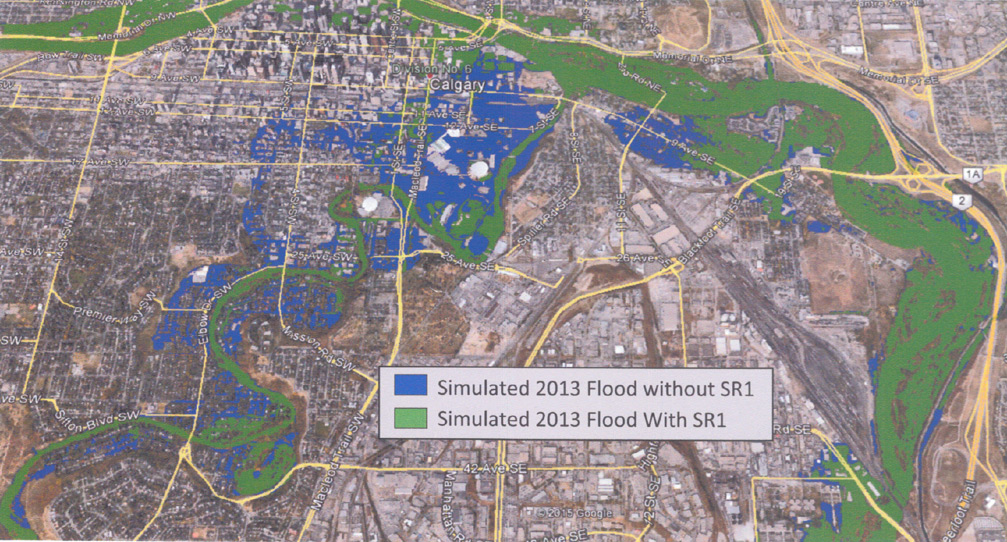Upstream solutions
On the Elbow River, the Springbank Upstream Dry Reservoir (Springbank Project) has been identified as the best solution.
The assessment
Experts presented three possible large-scale projects for the Elbow River to the Provincial Government in July 2014. They were the Springbank Project, the McLean Creek Dry Dam, and the Glenmore Reservoir Diversion Tunnel.
After reviewing all of the studies and reports, two separate Provincial Governments announced it would move forward with the Springbank Project. All options were carefully considered, including multiple stakeholder engagement sessions. Two were rejected, and plans are now in place for the Springbank Project to move ahead.
It’s the most cost-effective project, it’s quicker to build, and it’s got a larger catchment area – so we’ll be better able to protect Calgary and other downstream communities.
Adam Johnson, Public Affairs Officer, Alberta Transportation – August 2017
Why Springbank?
The Flood Mitigation Measures Assessment (FMMA) confirmed the Springbank Project combined with the installation of higher gates at the Glenmore Dam will mitigate a flood similar to the 2013 flood. It’s estimated that the flood risk will be reduced approximately 25 per cent by the new, higher gates on the Glenmore and an additional 75 per cent by the Springbank dry reservoir.
It’s also the solution with the best cost-benefit ratio.
Why not McLean Creek?
While the McLean Creek Project would have similar mitigation properties, there are critical characteristics that make it a less desirable solution.
| Parameter | Springbank Project | McLean Creek Dam |
|---|---|---|
| Catchment Area | 868 km2 | 695 km2 |
| Geohazard | Dam embankment: low risk of earthquake damage | Larger dam embankment and so possibly greater susceptibility to earthquake damage |
| Project Timeline | Operational 2020 | Operational 5.5 years from decision to move forward |
| Environmental Issues | Key Wildlife and Biodiversity Zone
Fish passage at the diversion structure may be affected by low flows in the Elbow RiverOff-stream reservoir does not affect fish habitat on the Elbow River Flow through river structure will have minimal impact on river morphology Directly impacts 22 acres of wetlands |
Key Wildlife and Biodiversity Zone, Grizzly Bear Zone (key habitat)
The dam creates a permanent barrier to fish movement on the Elbow River include Bull Trout, a federal species at risk The dam creates a permanent upstream pond changing the habitat from a riverine one to a lake one Blockage of river sediment transport by the dam will result in erosion and reshaping of river downstream Directly impacts 67 acres of wetlands |
| Flooding Risk During Construction | Minimal risk to downstream communities during construction | Potentially significant risk downstream if flood were to exceed the 1:50 year event, particularly during the first two years of dam construction |
| Cost | $372 million (including the estimated $60 million the government will recover from the sale of surplus land – if purchased at landowners’ request –following construction) | $406 million |
| Geotechnical Factors | No major foreseeable geotechnical issues. Dam construction will be off-stream away from the geotechnical effects of the Elbow River valley | The geotechnical issues associated with the McLean Creek option are significantly more complex than the Springbank Project |
While there is understandable concern expressed from some residents around the Springbank Project, the Provincial Government and the City of Calgary remain committed due to drawbacks of the McLean Creek Dam.
Upstream Bow River
There’s a Bow River Working Group that examined all possibilities. In a report issued in August 2017, proposed options for upstream storage include new potential storage sites and a further modification of TransAlta reservoir operations.
The current agreement between the Alberta government and TransAlta involves holding the reservoir at an elevation of 3902 feet until July 31, approximately six weeks longer than the current operating pattern. The modified operations at Ghost Reservoir reduce peak flows along the Bow River by an additional 100 cubic metres per second. TransAlta has several more reservoirs upstream on the Bow, and discussions have started regarding maximized potential for flood mitigation using this existing infrastructure.
City of Calgary Projects
Our municipal government committed $150 million to flood mitigation and resilience. Mitigation work that is already complete or is underway has reduced Calgary’s exposure to flood damage by about 30 per cent compared to 2013.
Based on recommendations from the Expert Management Panel (2014), 27 projects were identified, based on six action areas that emerged across six themes:
1. Managing
flood risk
2. Watershed
management
3. Event
forecasting
4. Storage, diversion
and protection
5. Infrastructure and
property resiliency
6. Changing
climate

